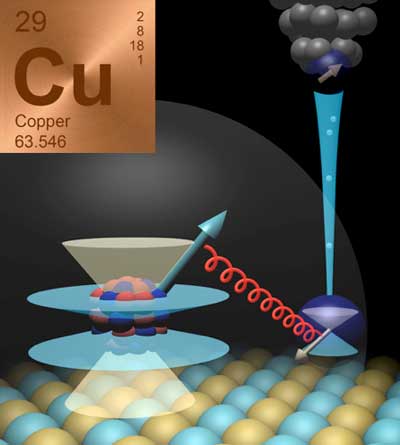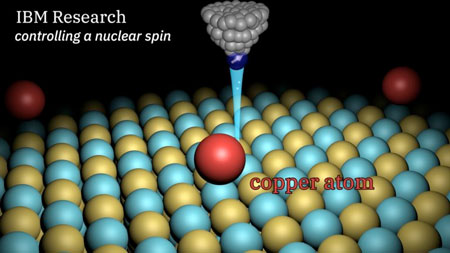| Nov 05, 2018 | |
In tune with the heart of a copper atom(Nanowerk News) Researchers at IBM Research developed a new technique to control the magnetism of a single copper atom, a technology that could one day allow individual atomic nuclei to store and process information. |
|
| In a paper published in the journal Nature Nanotechnology ("Electrically controlled nuclear polarization of individual atoms"), our team demonstrated that we can control the magnetism of a single atom’s nucleus by performing Nuclear Magnetic Resonance (NMR) one atom at a time. NMR is the process that underlies magnetic resonance imaging, or MRI, the technique that non-invasively reveals intricately detailed images of the body. NMR is also a critical tool used to determine the structures of molecules. | |
 |
|
| An artist’s view of the nuclear magnetism of a single copper atom. Cones represent different orientations of the magnetic north pole of the nucleus (left) and the electron (right) within the copper atom. The nucleus and the electron are magnetically linked (red spring). Electric current from the STM tip (shown at right) controls the atom's magnetism. (Image: IBM) | |
| This is the first time NMR has been achieved using a Scanning Tunneling Microscope (STM), the Nobel Prize-winning IBM invention that allows atoms to be viewed and moved individually, an important breakthrough because the STM can image and position each atom to study how the NMR changes and responds to the local environment. By scanning the ultra-sharp tip of the STM’s metal needle across the surface, the STM can sense the shape of single atoms and can pull or carry atoms into desired arrangements. | |
| Performing NMR on a single atom requires two major steps. First, we polarized (oriented in a well-defined direction) the magnetic direction of the nucleus. Then, we manipulated the magnetism of the nucleus by applying radio waves emanating from the tip of a sharp metal needle. The radio waves are tuned precisely to the natural frequency of the nucleus. | |
The copper atom with a magnetic heart |
|
| Copper is abundant and widely used in our everyday life, from electric wiring in houses to hooking up individual circuits in microchips. The usefulness of metal copper originates from its outstanding ability to conduct electricity. The magnetic properties of copper are much less well known - we never see a piece of copper attracted by a magnet. But copper’s magnetism comes to life when individual copper atoms are not surrounded by other copper atoms. | |
| When you shrink technology down to the most fundamental extreme – the atomic scale – a single copper atom can become magnetic, depending on how it interacts with the neighboring atoms that hold the copper. | |
| In our experiment, we made the copper atom magnetic by attaching it to a carefully chosen surface composed of magnesium oxide. This magnetism comes from the electrons in the copper atom. These electrons circulate around the nucleus – the “heart” of the atom – which, remarkably, is also magnetic. When we put two fridge magnets together, they either attract or repel. | |
| Similar physics hold for the electron magnet and the nuclear magnet, and the magnetic force between them tends to align them, so they point in the same direction. The technical term for this magnetic force within the atom is hyperfine interaction. | |
How to harness the magnetism of the nucleus |
|
| The weak magnetic signal of the nucleus makes it challenging to detect and control. The nuclear magnet is so tiny that its orientation fluctuates randomly due to heat, even when cooled to extremely low temperature as in our experiments. This makes it difficult to control the magnetic direction of the nucleus, called its “spin,” in order to use it to process information and sense other magnets. | |
| In MRI imaging, a very large magnetic field is used to align the nuclei in your body’s atoms to point in one direction. But heat disrupts this alignment so the nuclei point nearly in random directions, with only a slight tendency to follow the field. | |
| As a result, many trillions of atoms are required in MRI to produce a measurable signal. To control a single atom’s nucleus, it must be aligned much more predictably, a major challenge. Then each atom must be sensed individually to detect an NMR signal. | |
| To overcome these challenges, we use the electron orbiting the nucleus as a messenger as well as a manager. The electron inside the copper atom “talks” with the nucleus through the hyperfine interaction, in order to nudge the nucleus to point in the desired direction, and then senses the resulting direction. By detecting and controlling the copper electron using electric current, we detect and control the nuclear magnetism of a single copper atom. | |
| Our copper atom is attached to a carefully chosen surface, magnesium oxide, that allows us to probe the copper’s magnetism. To address the nuclear magnetism of a single copper atom, our team developed a specialized magnetic tip for the microscope by placing a single atom of iron at its extreme apex, which makes it possible to manipulate and detect the very weak magnetism of single atomic nucleus. | |
Single-atom NMR with current-controlled initialization |
|
| By simply using an electric current, we are able to transfer the magnetic orientation of the tip of the STM to the magnetic orientation of the core of a copper atom – the nucleus. This is similar to the spin-transfer torque technique, the method used to write information to magnetic bits in the next-generation computer memory known as MRAM. The animation above illustrates how the magnetism is transferred to the nucleus. | |
| After the nucleus is set to a desired orientation, we need to read out the barely tangible signal of nuclear orientation. To do this, we employ the electron spin residing on the same atom as a transmitter, building off of a previous paper published last month. We use a technique called “Electron Spin Resonance (ESR)” applied to individual atoms, a capability developed in the IBM Research – Almaden lab three years ago. | |
 |
|
| An artist’s view of single copper atoms (red balls) attached to a surface of magnesium oxide. The sharp tip (pyramid of gray balls) of a STM is probing a single copper atom by flowing electric current through it. (Image: IBM) | |
| Our team has taken a second big step in this work by demonstrating NMR of a single atom, by using a radio wave transmitted to the atom through the microscope’s tip. NMR techniques are widely used to study the structure of molecules and to image internal structures within the human body. Since the nucleus of copper is magnetic, a magnetic field exerts a force that causes it to process, similar to a spinning top tracing out cone-shaped surfaces while they precess in the earth’s gravitational field. | |
| The tiny “spinning” copper nuclei can orient themselves in only four different ways with respect to the magnetic field, according to the laws of quantum mechanics. This is why you see four cones associated with the nucleus in the figure and animation. By tuning the frequency of the radio wave emitted from the sharp tip of STM, to the characteristic precessing frequency of the “nuclear antenna,” we are able to resonantly rotate the orientation of the nuclear spin. | |
| We will combine this new ability to control the spin of the nucleus with the STM’s ability to arrange atoms to construct and probe electronic and magnetic devices that operate at the atomic scale, aiming toward using nuclear spins to process quantum information. |
| Source: IBM | |
|
Subscribe to a free copy of one of our daily Nanowerk Newsletter Email Digests with a compilation of all of the day's news. |
